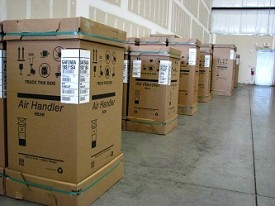Load Calculation is Step 1 for an A/C Install
 Bigger is not always better, especially when it comes time to install new central air conditioning. Choose a system that is just the right size for your home by using a Manual J load calculation, which follows the guidelines of the ACCA (Air Conditioning Contractors of America Association). This calculation takes into account both the architecture and the location of your house, as well as the optimal indoor temperature to keep you and your family comfortable during the summer months. Find out how.
Bigger is not always better, especially when it comes time to install new central air conditioning. Choose a system that is just the right size for your home by using a Manual J load calculation, which follows the guidelines of the ACCA (Air Conditioning Contractors of America Association). This calculation takes into account both the architecture and the location of your house, as well as the optimal indoor temperature to keep you and your family comfortable during the summer months. Find out how.
Calculate the Right A/C Size for Your Home
FACT: Building code in most states requires a load calculation before you install or replace central A/C; however, this is rarely checked up on. So unless you're dealing with a very reliable HVAC contractor, the installer may skip this step and rely instead on a general rule of thumb in choosing the size of the equipment.
In the past, a ratio of 1 ton of cooling equipment to every 400 feet of space was standard, but that has since been changed to 1 ton of cooling equipment per 600 feet, due to today's better sealed and insulated houses. However, this formula may still be an overestimation -- the ratio might be closer to 1 ton: 1000 feet.
Load calculation is a detailed, precise method of calculating the ideal size of cooling system for your home. This calculation used to have to be performed with painstaking care using pencil and paper; nowadays, specialized computer software makes it a much easier task.
Which Factors Play a Part in Load Calculation?
Every home is different. For this reason, A/C load calculation does not take into consideration only your property's total square footage. Other important factors include:
- Your local climate and geographic latitude
- The house's layout and age
- Its orientation (that is, which direction it faces)
- The number and location of windows, as well as their u-values and coverings
- Your roof's material and condition
- Any shade provided by overhangs or nearby trees
- Appliances and light fixtures inside the home and their degree of energy efficiency
- The number of human and animal occupants (who all raise the ambient temperature with the body heat that they give off).
If you already have HVAC ductwork in place, its layout and efficiency will be noted. Any "green" updates you have made to help with energy conservation, such as insulation and sealing, will also be part of the calculation. Finally, you will need to decide on your desired indoor summer temperature.
What are the Advantages of Correctly Sized A/C?
There are many advantages to performing an accurate load calculation:
1. Spend less on purchase and installation or replacement of air conditioning that is correctly sized for your needs.
2. Save money on running your new A/C system.
3. Prevent a common problem with an overly large system: "short cycling" (turning on, cooling your home quickly, then turning off), which results in uneven cooling and reduced comfort levels and tends to wear out the A/C more rapidly.
4. Avoid a related problem -- short cycling may also prevent your HVAC's dehumidification feature from kicking in, leaving your home with uncomfortably high relative humidity in the warmer months.
Laura Firszt writes for networx.com.
Looking for a Pro? Call us (866) 441-6648

Heating & cooling Average Costs
HVAC Contractors Experiences

Furnace Replacement So Our Heat Won’t Fail In The Winter Cold

Time To Replace The Heat Pump – Before It Broke Down Completely



